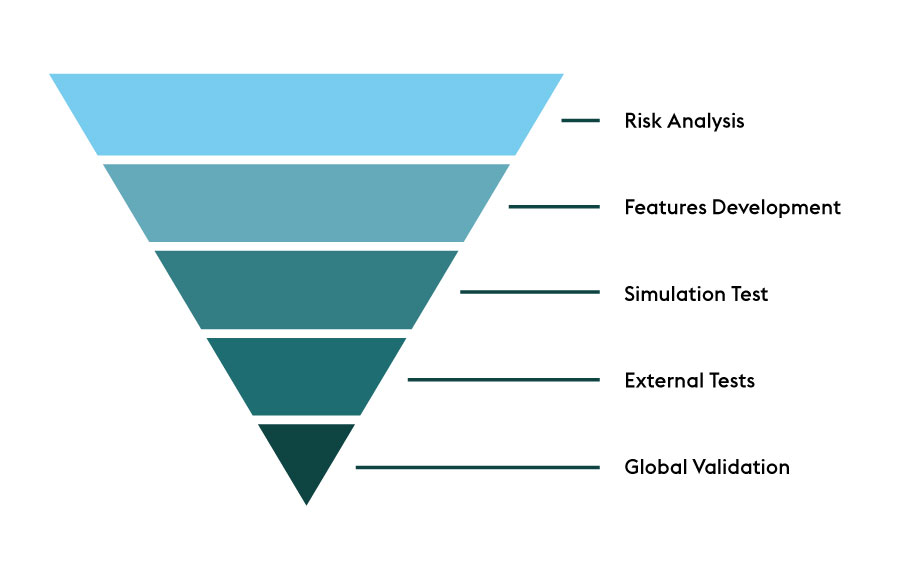Ultra wide band (UWB)
June 11, 2020 by valentin
Ultra wide band technology is particularly interesting in indoor environments. This technology is weakly impacted by interference from other communication frequencies. Indeed its spectrum and signal are radically different from other radio technologies. Squadrone System uses UWB components from different suppliers.
Newsletter
Don’t miss our news !
Our solutions

CLOVER
Autonomous Indoor Drone
Data capture,
inspection and monitoring
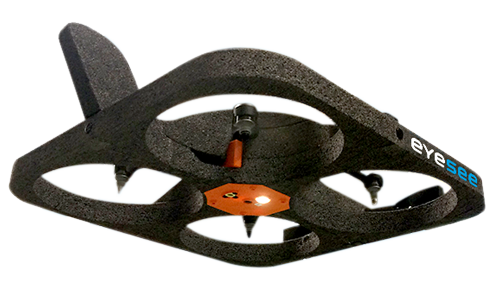
EYESEE
Autonomous inventory drone
Indoor inventory
by barcode reading
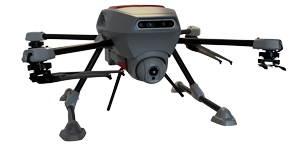
APACH
Drone with adaptable payload
Control, inspection, day and night
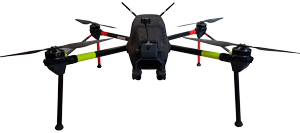
CROW
Fast and reactive drone
Aerial action with
adaptable payload
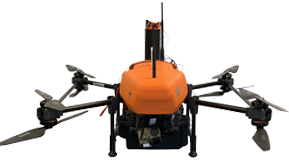
STORK
Transport drone
Multirotor or fixed wing,
complies with French aviation regulations
Last posts
6 September 2016UncategorizedDrone have been in the hype of news for a few years, you can see them fly in your local aprks and have read multiple news about how Amazon plans to deliver packages with drones or how Zipline delivers blood to African regions in need. Many consumer facing companies and other organisations, even the US government are intensely working on drone programs to accelerate their business, gain productivity and deliver higher value services to their customers. The drone eco-system has been flourishing with new companies from manufacturing to technology and service providers. However, there are still some major concerns preventing the massive deployment of drones for business or consumer use: regulations need to evolve towards an agreeable use for all, safety and robustness need to step up to be generally accepted and not feared anymore and finally, like any product, if it’s too hard to use, does it really bring value? Ease of use is key to general adoption.
Regulations
Although consumers have been rushing to buy drones and are flying them everywhere in your local park and above your head while hiking in the mountains, drones are still under restrictive rules of usage, cannot be used in cities, national parks, near airports and even local agencies restrict usage on their territory. AirMap is reflecting most of the no-fly zones on their app and the US government is putting effort into making consumers more aware and comply with the law, asking everybody to register their device, follow safety rules and respect people’s privacy. AirMap aims at setting low altitude airspace management for UAVs in order to make flying easier and safer for all.
On the commercial side, the brand new part 107 produced by the department of transportation and FAA effective since the beginning of the month just made it a lot easier to take advantage of drones capabilities for businesses. No more piloting license required or filing for an exemption which was a lengthy process for all parts.
We should therefore see more and more drones flying around for commercial purposes, due to regulations flexibility, the pressure of businesses willing to use drones to deliver high value services (remember Amazon’s proposal for air traffic segmentation?) and the emergence of UAV ecosystem players coalition pushing for the multiplication of usage, there is no doubt that drones will become easier and easier to fly in the skies.
Safety and robustness
Having an increasing number of UAVs above our heads is fine, as long as they don’t harm anyone, and this is a major society concern. Beyond privacy, you might remember the nearly fatal drone fall during the Ski World Championship last winter, falling right behind a skier on the slopes. Drones have been forbidden to fly in Rio around the Olympic games areas. You may also find all over the internet videos of drones falling from the sky or flying away for an inexplicable reason. It is critical that the industry players work towards making their systems unable to fail, under any condition, to be accepted by the general public, and most generally to be safe to be around, whether it is a public zone or not.
Devices need to be reliable and solid inside out: materials, components and architecture, just as much as in their brain, as they become more and more intelligent.
Failsafe behaviors, which are pre-programmed actions that will happen in case of unplanned situation, let’s say a motor failure and be able to fly with one or 2 less motors, anticipating low battery, GPS or connection loss plan for recovery or get a safe landing plan, are critical and too often neglected by too many manufacturers looking at penetrating the market as fast as possible, but this could cost a lot to the whole industry… Fortunately, industry leading manufacturers are integrating these features as they understand the need to overcome this fear to reach mass market adoption.
Additionally, beyond the failure events, an overall system quality is required and this goes through the quality of HW but also, and a lot through discipline of development and the ability to ensure the system will NOT fail. Just like civil aviation requires very strict development procedure, similar development methodologies for drones will increase robustness, therefore safety of devices. Finicky drones, fly aways and unknown errors are what make drones unreliable and eventually what ruins the experience. These have already been implemented by few companies and need to expand to a larger spectrum of devices. There are already ongoing discussions about safety certifications, pushing for increased robustness in systems and it will evolve in the right direction. As drones get more and more common in our everyday environment, this is “killer” feature, pun intented.
Ease of use
Drones have been heaven for hobbyists for many years allowing them the joy of building, piloting and seeing the world from above. As drones penetrate the consumer market, anybody can “technically” now pilot a drone and no need to build from scratch. Businesses that saw an interest in aerial shots with precision and accuracy still require someone techie enough to manipulate this engine, and that’s slowing down business. Indeed, the revolution will truly happen once it will be possible for anyone to easily operate a drone to get it to do what brings value to their job. Ultimate simplicity of use and intuitive interface will allow drone adoption. The good news is that, in the consumer market, we’re already seeing autonomous drones that do not require any piloting, whether from a remote control or a smartphone, they’re completely self-flying and will follow you around and avoiding obstacles, but interfaces are still a little clunky and still look very nerdy. This is kinda like the smartphones before the iPhone: very powerful machines with plenty of advanced functionalities accessible to consumers and businesses, but hardly navigable. The iPhone made smartphones usable and even enjoyable through a super simplified user interface. This is what needs to happen to the drone interface to allow literally everyone, at all levels to take advantage of this concentrate of technology.
Of course, drones need to add value to consumers and businesses to take-off, but for drones to truly fly everywhere and see the world benefit from the power of drones, it will require a combination of technology excellence to be 100% reliable and safe and incredibly easy to use interface which will make regulations evolve, in the right way.
Squadrone System enables anyone to capture any type of data providing easy to use self-flying devices that interact with an ecosystem of connected devices and applications.Squadrone has a proven track record of fast development cycle of intelligent systems. Leveraging on the autonomous flight technology developed for its first product, Hexo+, the company now extends its capabilities to B2B applications. [...]Read more...
20 December 2016UncategorizedNot having to pilot a drone is a key component to drone commercial and consumer usage. We’ve seen more and more solutions taking-off, however raising some safety concerns when there’s no pilot in cockpit. We’re sharing here 3 good practices of our development process that allows Squadrone System to guarantee reliable, robust and safe flight.
On our first project, called Hexo+, the first self-flying camera for consumers launched in 2014, one of the biggest challenge to bring the first drone that is NOT piloted to the public was to ensure that it could actually fly reliably without the user’s intervention, never requiring piloting skills. Getting a fully autonomous system means that you need to trust the technology (hardware + software) and rely on sensors.
True autonomous systems required qualified sensors
Taking care of the basics sensors and material drawbacks is more complex than it seems. We faced many sensor limitations and issues during the development of Hexo+. In the civil aeronautics field, the best sensors are selected for their reliability and extremely good performances. Nevertheless, those sensors are very expensive, heavy and redundant, not suitable for a consumer facing product aiming at making aerial filming accessible to all. We therefore looked at consumer-affordable sensors, delivering acceptable performances, but with some limitations that have to be known.
When controlling the drone with a remote control, the human pilot always counteracts the drawbacks of the sensors of the drone. For instance, it is known that compass typically drifts while in flight. Under RC operations, the pilot constantly controls the yaw of the drone to maintain its heading and the performances of the system are not affected. In a fully autonomous system, a compass’ failure induces the drone to perform fast and large circles (called toilet bowl effect) leading to serious crash and potential damages. The same observations can be made when a motor is getting lost on the system, when a propeller is broken, when any other sensors is not perfectly working. Truly autonomous systems need to rely on sensors and have capabilities to counter-act in case of sensors failure.
Sensors and material limitations are one component to master in the development of a safe device, unfortunately they are not the only items that can go wrong on an autonomous system, that’s why we took it to the next level.
Risk analysis – anticipating the worst case scenario
At the origin of the development, we built a risk analysis matrix, with a description of the risk, the likeliness to happen, the consequences of it happening to make the inventory of all possible safety issues a user can encounter.
From a sensor failure, to motor breakdown to GPS loss, worst case scenario have been tackled by safety features implemented in the drone and the app, they’re called Failsafe behaviors.
At Squadrone System, we are convinced one of the key of adoption is the robustness of the system. Indeed, to make a technology acceptable to use around your family, your property, your business, people need to build trust in the system, that is why creating safe and robust drones has always been at the heart of all our developments.
Our background in developing critical software for aeronautic applications allows us to be extremely aware of the failures possible and able to anticipate them. We leverage this experience to build fault tree analysis in our evaluation of risks, foundations for the construction of reliable hardware and software systems.
Continuous test through development
According to Les Hatton, professor at the University of Kingston in London, problems linked to programmation errors cost up to 150 billion Euros per year, in Europe only, and as we embed more and more code into systems to make them smarter, this number will rather increase in the coming years.
Once some features are programmed, all the code is run on a simulator inside the company. When it gives satisfactory results, those software tests are then always run by the simulator thousands of time and it is time for real external tests to validate the real behavior of the feature. We conduct both unitary test, where each functionality is tested individually, and integration tests to make sure the development executes as planned without affecting the rest of the code. Finally, global validation tests are performed by our test team. The objective is to validate the whole behavior of the complete system, looking at the potential interactions between all the functionalities. We apply a thorough real life tests methodology, testing each individual feature on a multitude of cases and locations, then combining features and errors to test the reaction of all behaviors together.
A study led by RMIT University School of Engineering and published in Aerospace states that researchers looked at 150 reported incidents between around 2006 and 2016, and found that 64 percent of incidents were because of technical problems. In most cases, they found that broken communication links were to blame.
By applying a detailed and intense real life testing phase, our methodology has proven to bring up some issues that we wouldn’t want consumers to experience. With drones, it’s always better safe than sorry!
Developing a complete intelligent systems requires deep understanding and mastering of all the components of the system. Taking the time to anticipate all scenarios, especially the worsts, and thoroughly test the whole solution in different situations ensure a safe and robust system, dramatically improving user experience and eventually, allowing all drones opportunities to take off. [...]Read more...

